Momo. What comes to your mind? What do the tiny, pleated packages stuffed with vegetables or meat invoke? For me, they serve as a reminder of home. The labour process, time spent with loved ones, and joy as we huddled around the kitchen table creating and sharing steaming crescents dripping with achaar. “My most vivid memories constantly jog my brain with the recollection of how things tasted” (Knisley, 2013). Throughout the years I lived away from home, whenever the homesick bug bit me I craved a plate of momo. I recount eating cabbage momo in Kurseong’s Naya Bazaar, sweating over plates of ‘chilly momo’ in Siliguri’s Hongkong Market, and the auto trips to New Aruna Nagar (MKT, a Tibetan settlement in North Delhi). I remember going to Kamla Nagar and waiting in line for Dolma Aunty’s ‘paneer momo’, and dipping the momo in the spicy red tomato achaar. Also, the momo parties where we gathered at a friend’s place who owned a ‘moktu’ (momo steamer) to make momo. A group of homesick students whose momo was far from perfect, huddled around a table remembering home.
Momo. What comes to your mind? What do the tiny, pleated packages stuffed with vegetables or meat invoke? For me, they serve as a reminder of home
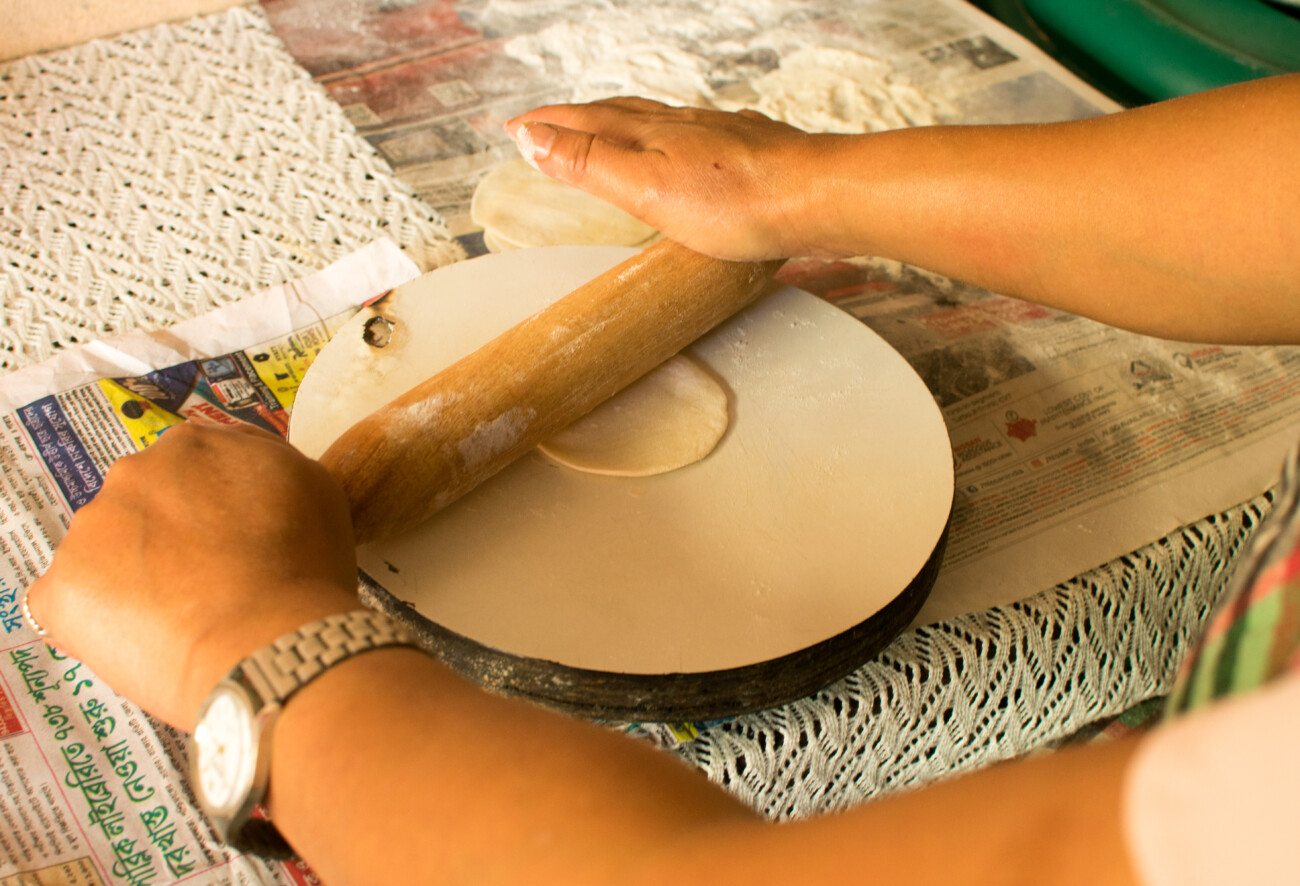
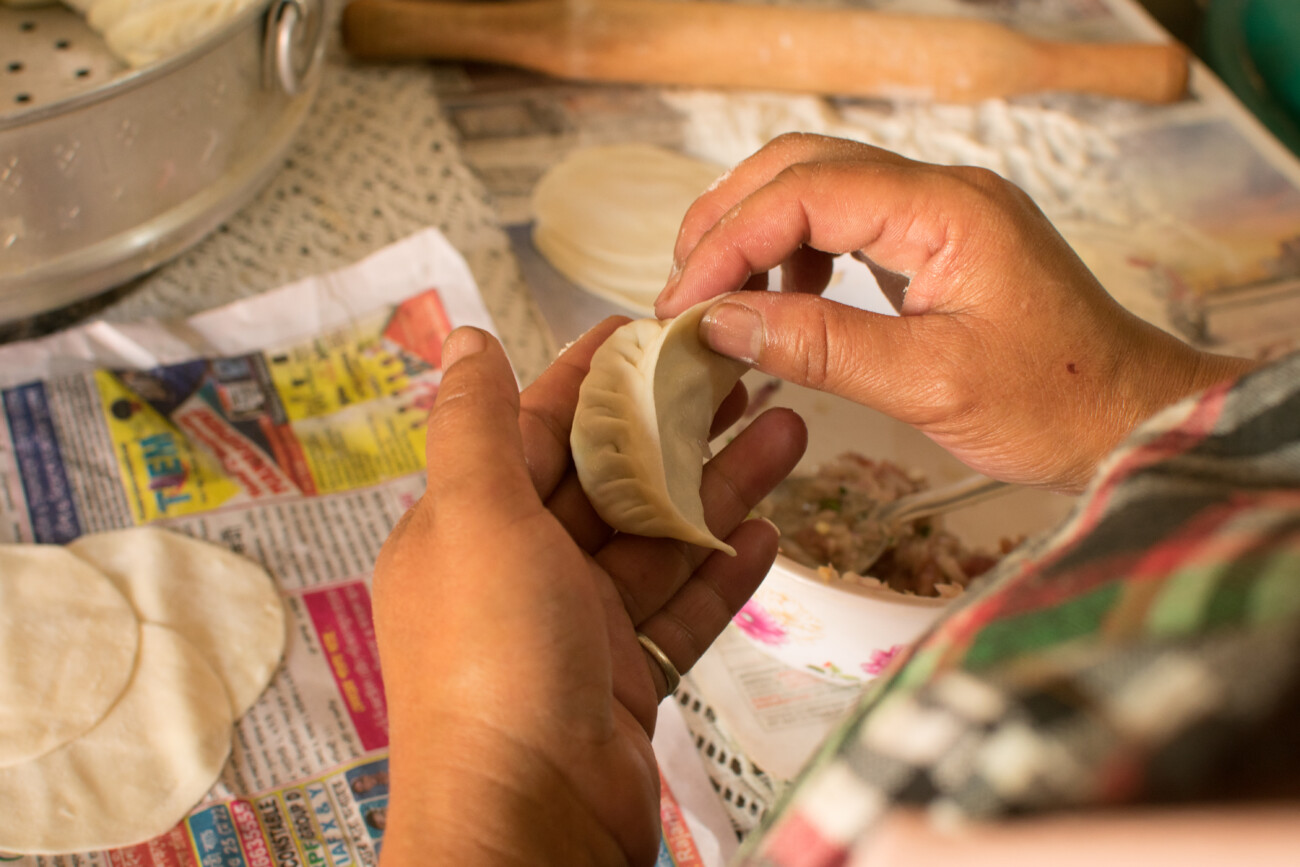
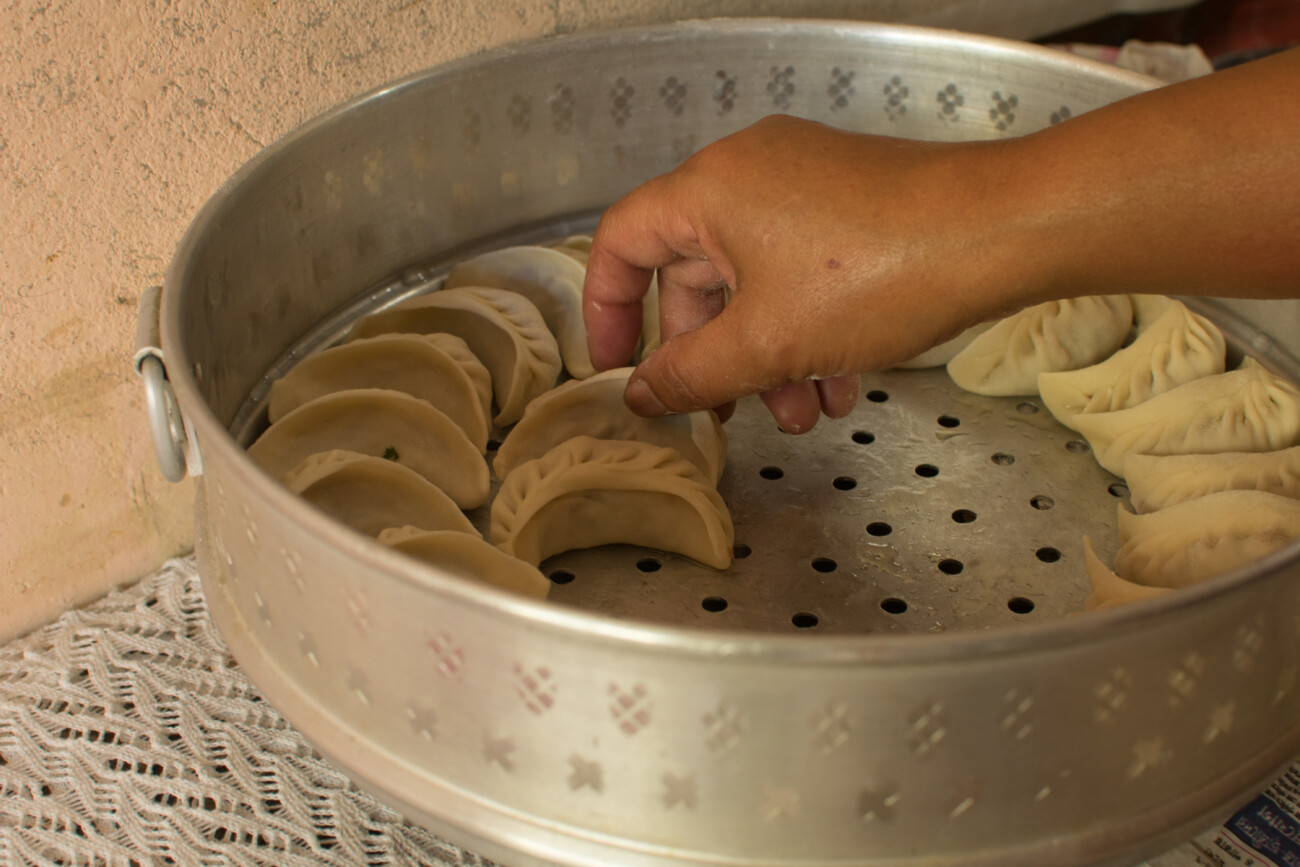
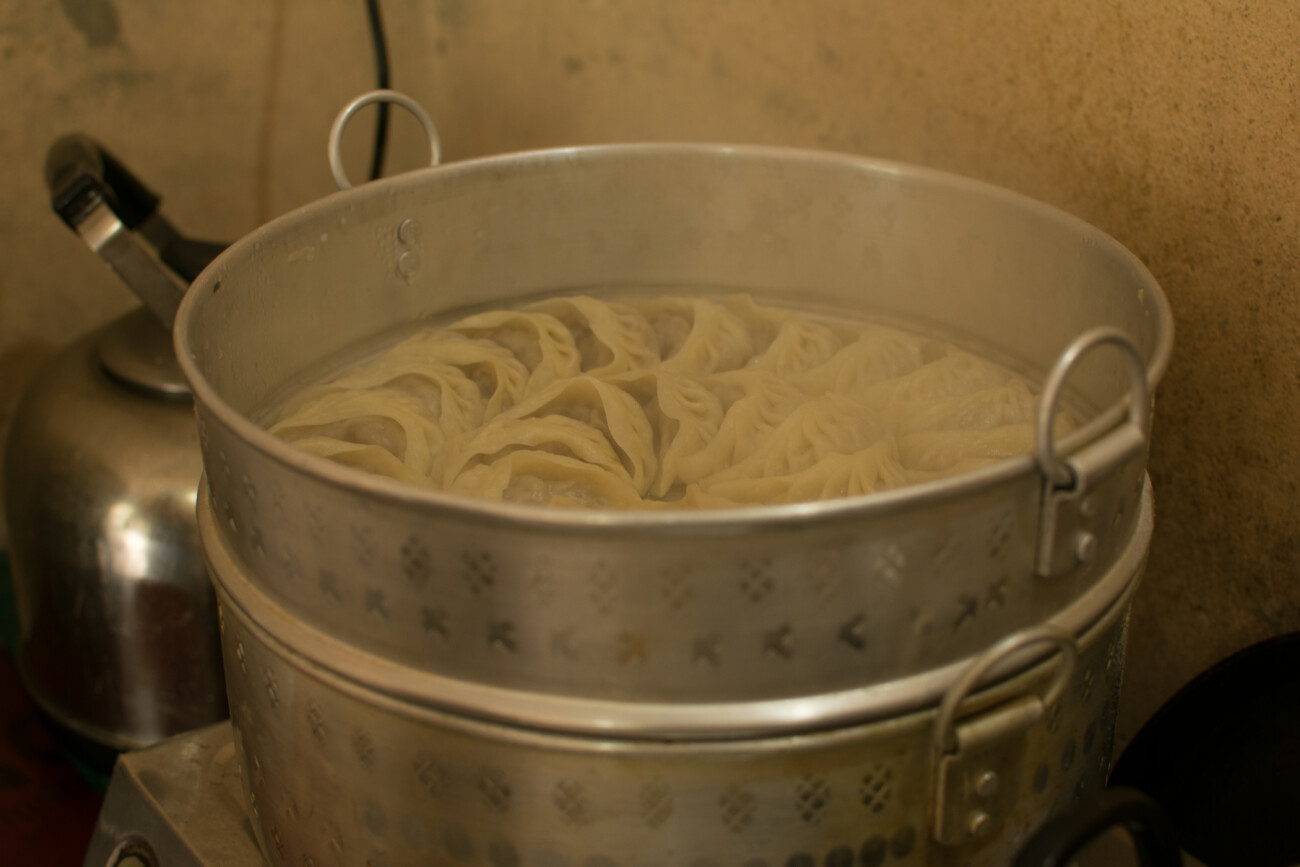
The Momo Making Process (Rolling, Pleating, Placing, Steaming)/ Photo: Samiksha Gurung
In 2022 when I wrote a poem called ‘Momos for Dinner’, people reiterated, “It is momo, not momos”. In the Darjeeling hills and Sikkim, we have grown up with ‘momo’. It is a significant part of our culture, having been passed down from the Tibetan community to the inculcation of ‘momo’ in our everyday. These little packages hold a context of hybridity and made me think about how the word ‘momos’ entered my vocabulary. As many Tibetans and Indian Nepali/ Gorkha people believe that the correct term is ‘Momo’. Dorje (1985) says “Momo the same word is used for singular and plural”, he also shared a Tibetan proverb “Kha momo nangshin dhe” (keep your mouth closed like a momo). During my five years in Delhi, I saw people raving about ‘momos’. But on the flip side whenever I encountered racism, this very taste of home ‘momo’ turned into a racist slur. People claim to adore momo, but use the very same word to belittle ‘chinky’ Indians, Tibetans, and Nepalese. This is the experience of many people from the Northeastern region (including the Darjeeling Himalayas) across India. It isn’t just the ‘momo’, but other foods associated with us like noodles, chowmein, and so on. “Food and consumption are entangled with the social history of belonging, and the divergent experiences of citizenship and modernity in India” (Kikon, 2018). This article focuses on ‘momo’- the word as well as the dish, highlighting cultural hybridisation and racism. It seeks to speak of ‘momo’ as- home, memory, history, and culture served on a
plate.
Tracing the origin of Momo and its popularity across India (Darjeeling Himalayas, Sikkim and Delhi)
"To invoke and remember home is to start by exploring the ways in which relationships,
obligations, and ways of belonging are established".
-Kikon, D. (2018).
There are various stories tracing the origin of the momo, but its history remains unclear.
“Momo is an ethnic food of Himalayan communities. It is a steamed dumpling made from wheat dough and stuffed with minced meat, vegetables, spices and herbs usually served with chutneys/pickles/sauces/meat broth/soup” (Bepary et al., 2015). Sijapati (2016) writes during the 17th century, dumplings were already a staple snack in Lhasa when trade relations flourished between Kathmandu and Tibet. Soongma Tuladhar (an educator and aformer merchant in Tibet) shared that the original dumplings made with yak meat and onions morphed into momos we know today after they were introduced in the Valley by returning Newar traders From Tibet. “By the 1960s, in part because of the influx of Tibetan migrants, momo-chas were already a popular fixture at Kathmandu’s handful of cinemas” (Sijapati, 2016). Momo then spread across Northeast India, Darjeeling, North Bengal, and nearby states through cross-border travels and migrations of people (Bepary et al., 2015).
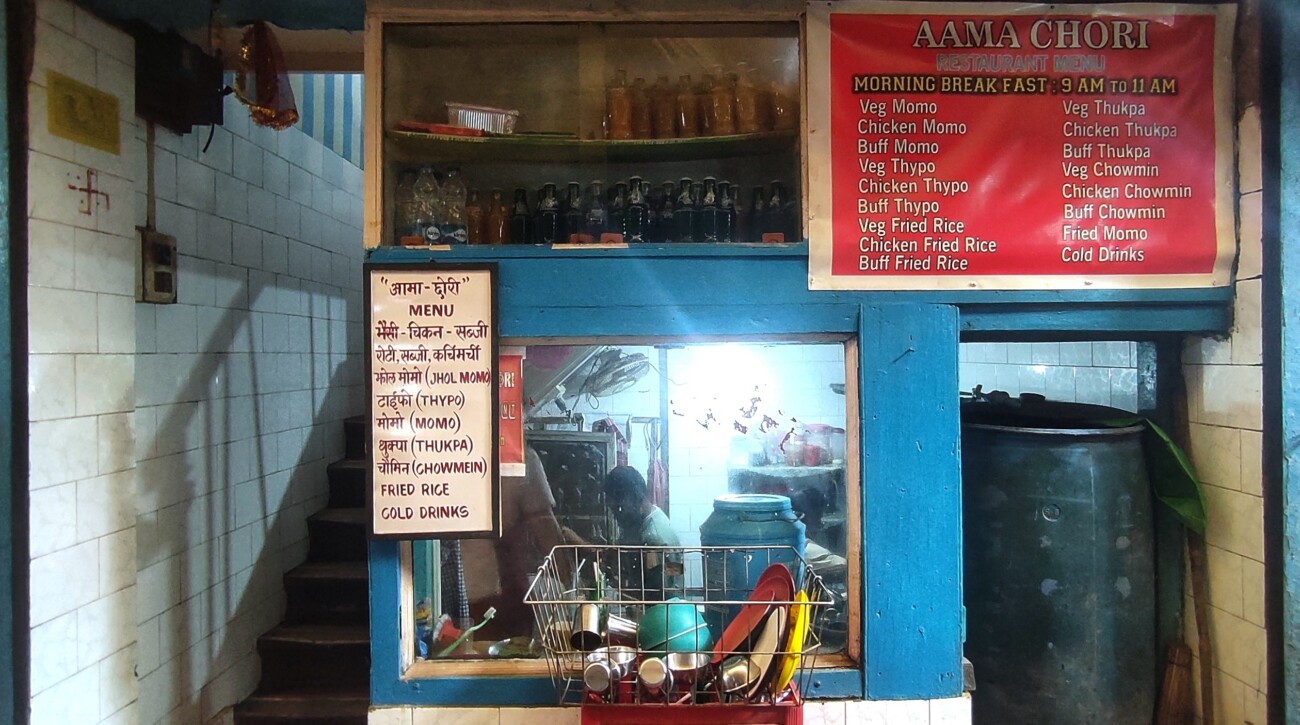
A momo restaurant in Darjeeling/ Photo: Ruchi Dyeksang
Momo’s history remains ambiguous. The momo is said to have originated in the 14 th century,
with Nepal and Tibet claiming to be the birthplace. There are two theories on how the momo
entered India; the first being that in the 1960s a large number of Tibetans settled across the
country in regions like Ladakh, Darjeeling, Dharamshala, Sikkim, and Delhi (major momo
hotspots), while the other theory credits Kathmandu’s Newar merchants (Pushkarna, 2021). I
was curious about how this dish became a part of our lives. My parents say that in 1960s
Darjeeling, when they were school students, the momo was a delicacy available only in
restaurants. “Back then momo was made mostly of beef and pork, one plate consisted of
four pieces with soup and achaar, costing around an atthana (50 paise). The shops mostly
belonged to Tibetan people and a few Chinese and Nepali eateries. Vegetable momo is a
recent entry. Slowly from the 1970s onward momo got inculcated into the Indian
Gorkha/Nepali culture, with people making momo at home”. My father learned how to make
momo from his Lepcha hostel warden and taught the recipe to my family.
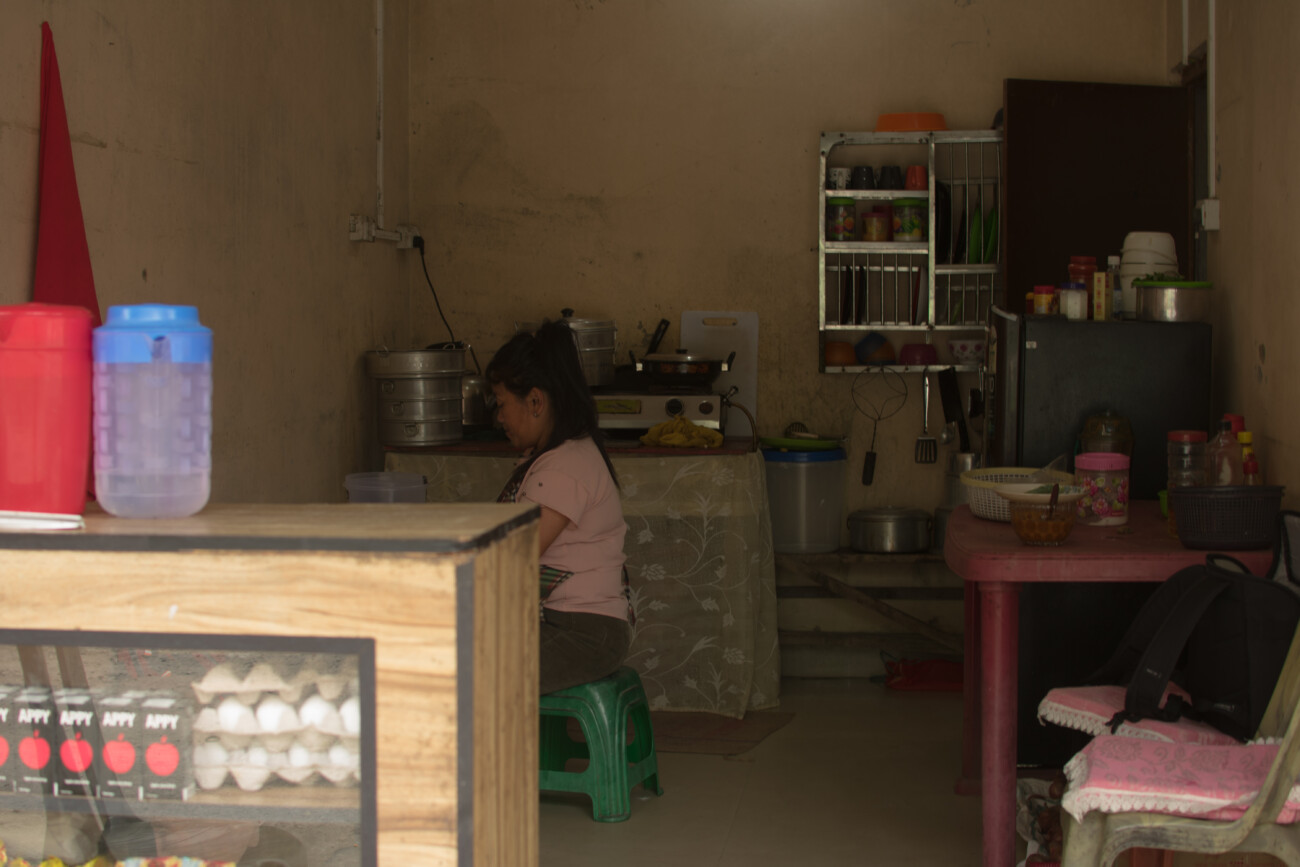
A momo restaurant in Namchi, Sikkim/ Photo: Samiksha Gurung
In 2021, India was declared as the “Nation of Momo Lovers” after over 1 crore people ordered momo from Zomato (Malik, 2021).
My experience of moving to Delhi for further studies was a mixed bag. On one side there
was homesickness and alienation, on the other side it was a new and exciting environment.
One pleasant surprise was seeing momo everywhere. As Sherpa and Singh (2022) mention,
“momos are now an omnipresent sight on every street corner in Delhi, it has become an
irrefutable part of the urban foodscape, so much that of all places, Delhi has become synonymous with momos”. It isn’t just Delhi, momo is now a commonly sighted dish across India. In 2021, India was declared as the “Nation of Momo Lovers” after over 1 crore people ordered momo from Zomato (Malik, 2021).
Momo: What is in a name?
“Food is central to our sense of identity. The way any given human group eats helps it assert its diversity, hierarchy, and organization, but also, at the same time, both its oneness and the otherness of whoever eats differently. Food is also central to individual identity, in that any given human individual is constructed, biologically, psychologically and socially by the foods he/she chooses to incorporate.” - Fischler. C. (1988).
The momo has many stories surrounding the origin of its name. Wikipedia states that “momo
is the colloquial form of the Tibetan word ‘mog mog’, saying this Tibetan word may have been borrowed from the Chinese term ’momo’ a name traditionally used in northwestern Chinese dialects for wheat steamed buns and bread”. Meanwhile, Soongma Tuladhar (a former merchant in Tibet) shared that Nepali versions were called ‘momo-cha’ (cha being a term of endearment for anything small in the Newar language) because they were shaped small like marbles (Sijapati, 2016). A blog source also states that “Mome refers to steam cooking in Newari, one of the oldest languages of Nepal” (Karki, 2020).
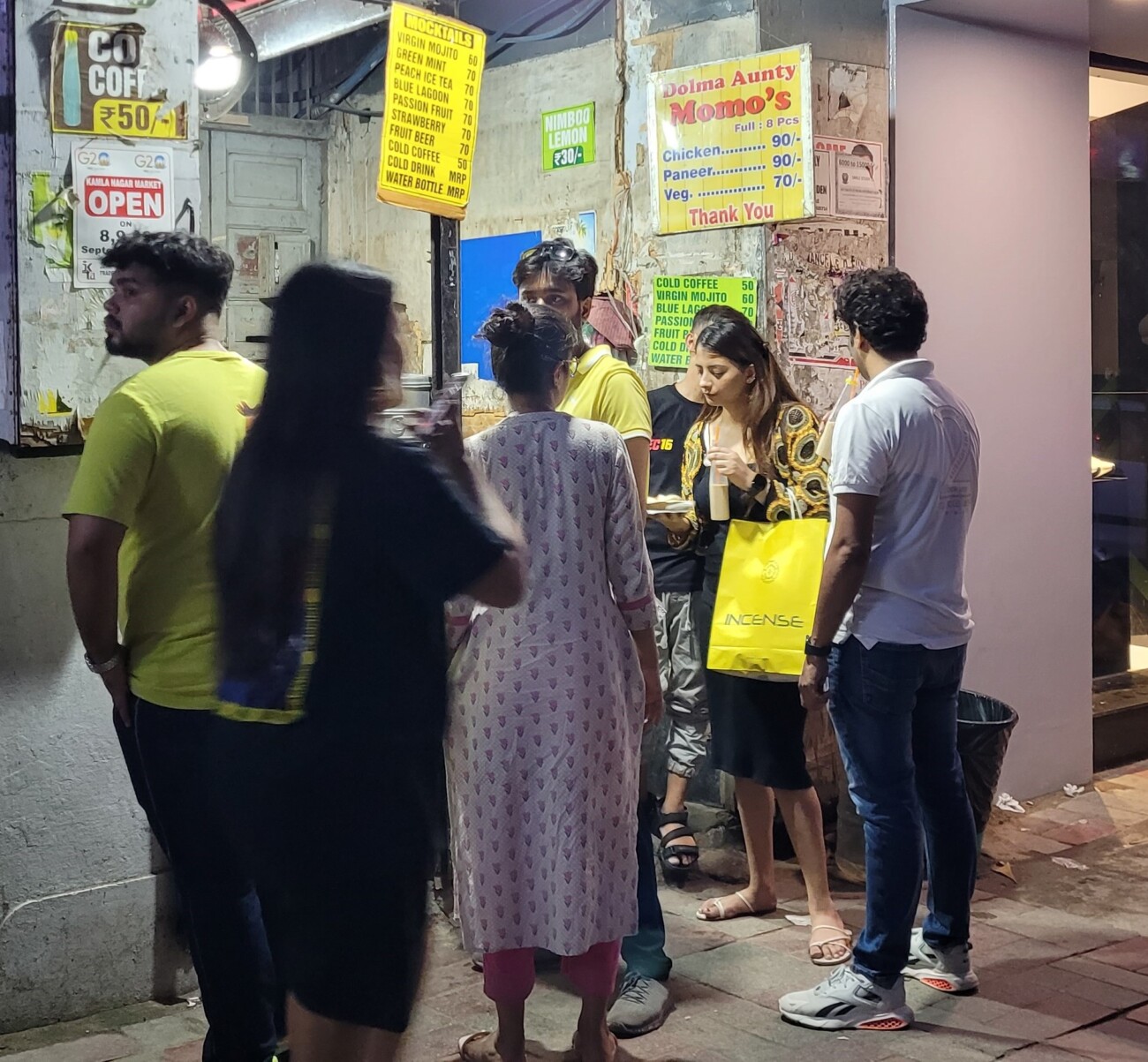
Dolma Aunty Momo’s, Kamla Nagar, Delhi / Photo: Nangsel Sherpa
We may never uncover the precise genesis behind the momo’s name but the word itself has
altered: from ’Momo’ to ‘Momos’ while making its way from the hills to the plains of India. In
the introduction, I have spoken of how despite being a resident of Darjeeling my poem was
unintentionally named ‘Momos for Dinner’. This transformation of the word ‘Momo’ into
‘Momos’ can be viewed as an instance of cultural hybridisation- the convergence of different
elements of various cultures (food, language, fashion, music, etc.). And without me realising,
somewhere while traversing my way across Delhi, ‘momo’ had become ‘momos’.
“Momo is a dish that has become synonymous with the term ‘street food’ in Delhi. Delhiites
are often spotted relishing hot steaming plates of this Himalayan dish, with a dash of
mayonnaise on the side” (Sharad, 2022). In Delhi, I saw many people around me declaring
themselves fans of momo; and it was good to see our taste of home being appreciated. But
on the flip side, when we encountered racism the very same dish ‘Momo’ metamorphosed
into a racial slur. Racism was a daily occurrence in Delhi as a ‘chinky’ woman. But what
appalled me is how the foods associated with us like- momo, chowmein, noodles became
terms of disparagement. There have been instances when someone has shouted “Oie
Chowmein, Oie Noodles” at me, while the crowd snickered. The discrepancy between the
apparent adoration for the food momo, and the treatment meted out to the people associated
with the cuisine continues to baffle me. As Misra (2016) states, “Momo-wallahs (momo-
selling guy, in local parlance) are everywhere, and everyone has their favourite. Yet
members of the Tibetan diaspora throughout Delhi still suffer from legal troubles, political
exclusion, and—like migrants from Bhutan, Nepal, and India’s northeastern states—often
encounter economic and racial discrimination. They work jobs that help the city run, send
their kids to school, and contribute to the economy and culture. Yet they’re not truly
accepted. Only their cuisine has spread like wildfire”.
Momo: Incorporation and Segregation in India (Northeastern and Indian)
“Everyday processes of acquiring, rejecting, or negotiating tastes and dietary sensibilities capture the contextual and political parameters of tradition, articulations of contested belongings, and different experiences of citizenship in India.”
-Kikon, D. (2018).
Today, the momo is considered to be India’s number-one street food and is estimated to be close to a $2.7 billion market, of which 97 percent is unorganised (Fernandes, 2022). Gradually, momo has become incorporated into the cuisine of India. “To incorporate a food is, in both real and imaginary terms, to incorporate all or some of its properties: we become what we eat. Incorporation is a foundation for identity” (Fischler, 1988). We have seen a steady rise in hybridised versions of the momo; at present fifteen varieties are found across India: from the original steamed momo, to the well-known fried momo, jhol (soup) momo, kothe (dotted) momo, chilly momo, paneer momo, also recent creations like tandoori momo, and chocolate momo (Kandpal, 2014). “Momos are available in all cities and towns of India with different types of stuffing and services. It created a new venture of entrepreneurship development, and it is sold by small mobile momo vendors as well as in big restaurants” (Bepary et al.,2015). There has also been a rise in momo franchises across India like- Wow Momo, Momomia Franchise, Nainital Momos, House of Momos, and Momo Station (startupyo.com). We notice that mainland Indians have become momo vendors as well. Despite the apparent incorporation of the momo, the people associated with it are still segregated.
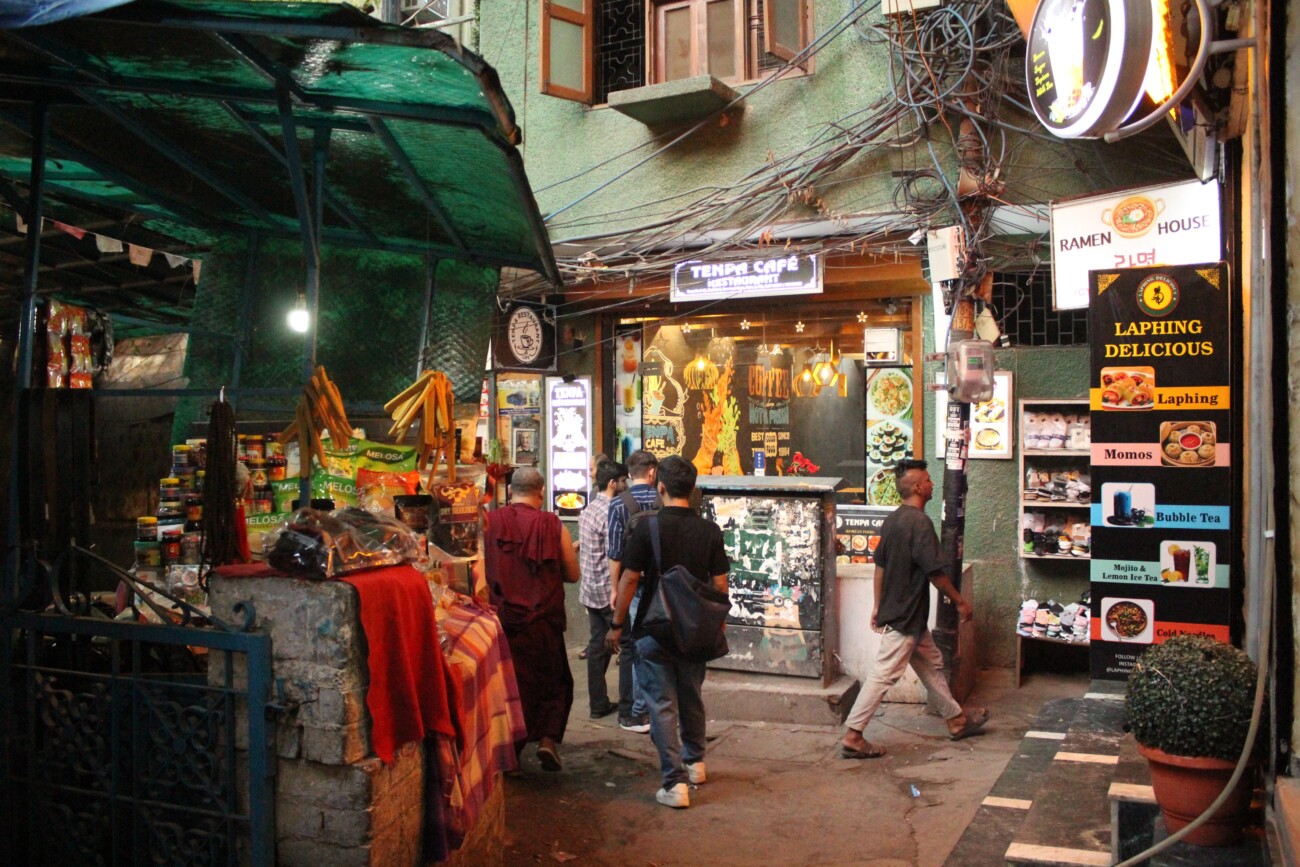
A street in New Aruna Nagar Colony (MKT), Delhi/ Photo: Keshav Kaushal
In India, the term ‘Northeastern’ is associated with people who have certain physical features ascribing to the colonial racialized category of ‘mongoloid’, irrespective of their origins and ethnic/cultural diversity. “This definition also extends to people from the Himalayan regions of the Indian subcontinent (like Ladakh and Darjeeling) who have been historically racialized along similar lines”. Furthermore, due to “external racialization”, people who are not from the Northeast but fall under the “colonial mongoloid category” like people from the neighbouring countries (like Nepal and Bhutan) become externally identified and racialized as ‘Northeastern’ (Rai, 2021: 2 with 11). “In the context of the Northeast in contemporary India, racism can be explained through the notion of a centre-periphery power relationship. Rai (ibid) says that racism discourse in relation to the ‘Northeastern’ category can be contextualized within the migration from the Northeast and Himalayan regions to the urban centers in mainland India, manifesting in racism at three levels- the Individual (racial slurs toacts of explicit violence), the Institutional (universities, labour market institutions, workplaces, and cultural/economic industries of cities), and the Structural (Rai, 2021: 13 with 14).
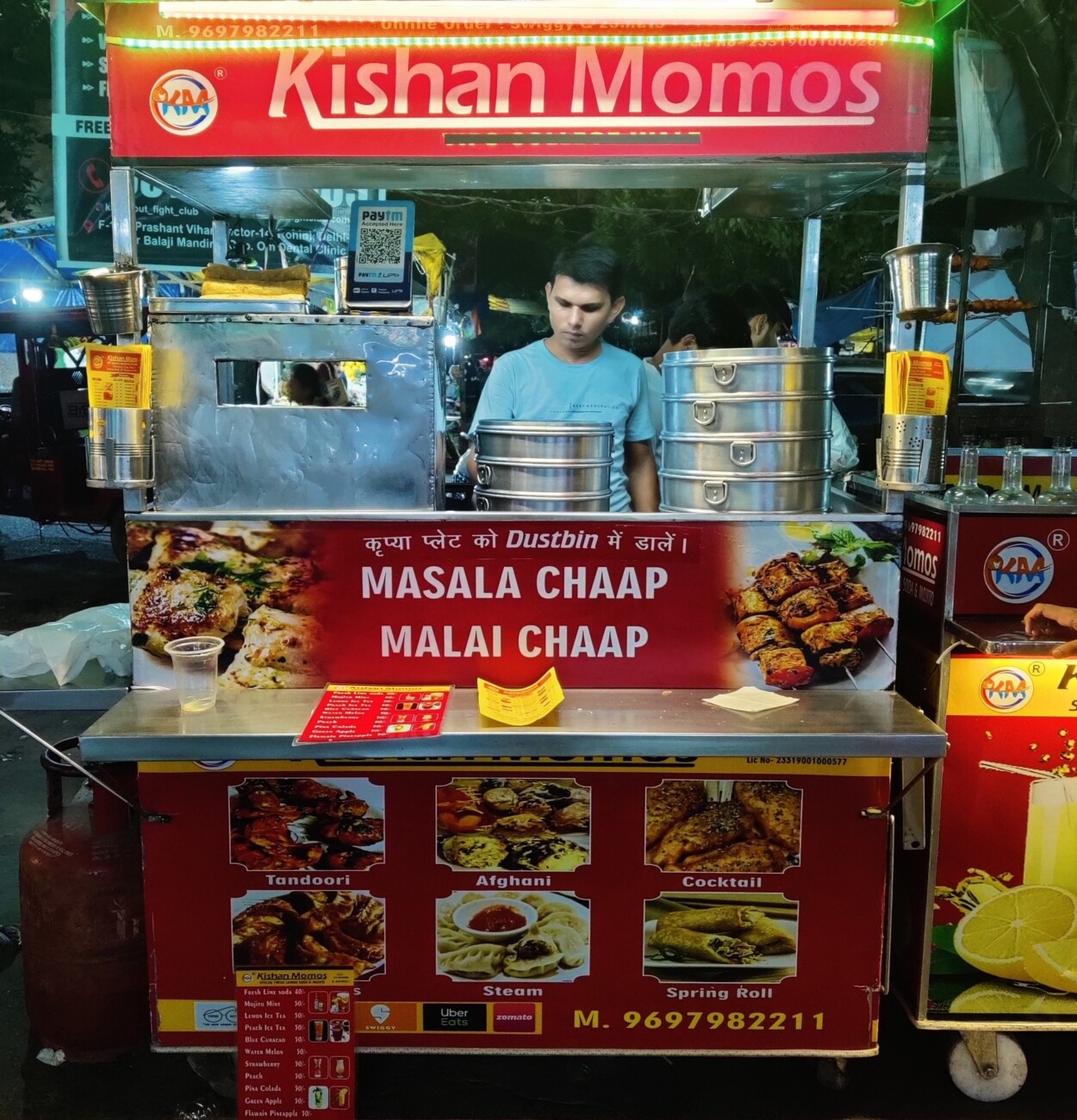
Kishan Momos, Rohini, Delhi/ Photo: Keshav Kaushal
Misra (2016) speaks of how momo being a good street food has brought together folks from
all walks of life, “in sprawling and unequal Delhi, they’re tongue-tingling equalizers. The city,
however, can do better to accept the communities that have brought its residents this treat”.
Most Northeasterners, Indian Nepalis/Gorkhas, Tibetans, and Nepalese people will recount being called 'Momo’ alongside ‘Chinki’ at some point in time. In 2017, Ramesh Arora a
lawyer and BJP legislator of Jammu sought a ban on momo. “He said that Momos contain
the carcinogenic monosodium glutamate or Ajinomoto which is harmful to the body. Arora is also a strong advocate for banning not just momos but the 'cancer-causing' Chinese cuisine
altogether” (Outlook, 2017). A national party member openly condemning a popular yet
marginalised food item, alongside the racist aspect of grouping momo under the banner of
‘Chinese cuisine’ and calling it “cancer-causing”, seems like racism and nationalism under
the guise of concerns over public health. Fischler (1988) has stated that food is the favoured
instrument of control over the self, and this event seemed like an attempt to further
marginalise minority communities for whom momo not only signified home, but also sought
to jeopardize the livelihood of multiple momo vendors (Northeastern, Mainland, Tibetan, and
Nepalese). “Any conflict about eliminating or retaining food from the table necessitates how
one engages with dietary practices of consumption, understanding, everyday politics,
geographies, and peoples’ histories” (Kikon, 2018). This event seemed to reflect the racism
bubbling beneath the façade of apparent acceptance.
These tiny crescent-pleated packages have traveled across lands into homes and street corners across India. In doing so they have entered the realm of the public and have evolved to incorporate diverse tastes and preferences.
“Food is a personal genealogy and cultural artifact: perched at the intersection of the
domestic, the political, family and society, and sprawling magnificently across those
thousands of interconnected islands” (Tandoh, 2020). Momo isn’t solely a personal memory
but a shared collective memory. Tursheen (2020) says, “When I trace my own family and its
tiny community, the string between food and community runs deep”. Similarly for us, a plate
of momo signifies- home, memory, history, and culture on a plate. These tiny crescent-
pleated packages have traveled across lands into homes and street corners across India. In
doing so they have entered the realm of the public and have evolved to incorporate diverse
tastes and preferences. India is now considered one of the largest producers and consumers
of momo. Despite this, why has a beloved dish that people line up for evolved into a racial
slur? Why are the people associated with this dish still marginalised?
References
- Knisley, Lucy. Relish: My Life in the Kitchen. First Second, 2013.
- Dorje, Rinjing. Food in Tibetan Life. Prospect Books, 1985.
- Kikon, Dolly. “Eating Akhuni in India”. Farm to Fingers. Cambridge University Press,
2018. - Bepary, Wadikar, and Patki. “Momo- A Traditional Food of the Himalayan Belt”. Research
Gate, 2015. - Sijapati, Alisha. “A juicy love affair”. Kathmandu Post, 2016.
- Pushkarna, Kritika. “The interesting stories of how momo came to India”. Times of India,
2021. - Sherpa and Singh. “No laphing matter”. Himal Southasian, 2022.
- Malik, Bismah, “Nation of Momo lovers: over 1 crore people ordered momos”. Business
Today, 2021. - Fischler, Claude. “Food, Self and Identity”. Social Science Information, 1988.
- Wikipedia
- Karki, Yubraj. “The history of momo”. Everest Cuisine, 2020.
- Sharad, Aparajita. “The Saga of every Delhiite’s favourite street food: Momo”. Slurrp,
2022. - Misra, Tanvi. “Delhi’s Dumpling Divide”. Citylab, 2016.
- Kandpal, Aanchal. “15 lip-smacking momos”. Scoopwhoop, 2014.
- “5 Best profitable momo franchises in India”. startupyo.com.
- Rai, Rohini. “From colonial ‘mongoloid’ to neoliberal ‘northeastern’: theorising ‘race’,
racialization and racism in contemporary India”. Asian Ethnicity. Routledge Press, 2021. - “BJP’s Jammu legislator wants momos banned because it causes diseases.” Outlook,
2017. - Turshen, Julia. “Food is a bridge to community”. In the Kitchen. Daunt Books, 2020.
- Tandoh, Ruby. “Tikim Nang Tikim”. In the Kitchen. Daunt Books, 2020.
Momos for Dinner
Morning is greeted by
the winter sun and
aju momo khane la. (Let us eat momo today)
The squashes stand ready
prickly and green,
a huge steel bowl holds minced pork.
Papa is already at the onions
purplish-pink bringing tears to one’s eyes.
He places them in the grinder,
s-l-o-w-l-y pulls the string.
A constant tug of war,
Papa tells me patience.
I remember the day
I decided to mince onions myself:
s-t-u-c-k string, still blades
shaky hands, c-o-l-d breath.
My family often prides themselves
for p-r-e-s-e-r-v-a-t-i-o-n.
My c-o-n-s-u-m-e-r-i-s-m
tells them I need a new phone.
Papa brandishes his seven-year-old phone
saying still good,
taking care goes a long way.
I finally manage to get the blades whirring,
sliced onions always bring tears.
Ama is cutting squashes,
I have yet to learn.
The older the pricklier,
my fingers fail to grasp them.
They look at me and say in unison.
“Do not be weak and delicate,
be strong and tough,
let nothing get to you”.
Even when your palm’s s-k-i-n
is seared by the moktu’s heat,
hold it with bare hands.
I look at their hands;
as I grow, I forget
they are getting older.
Papa’s hands hold knotted fingers,
he says don’t crack your knuckles.
Spots are spreading on Ama’s hands,
I see new lines running across her palms
as if life is borne by them.
They say sit down,
learn how to mix the masala:
O-n-i-o-n-s pink-red
lots of them,
G-i-n-g-e-r minced
squeeze the juice not a lot
or else it will turn bitter,
S-a-l-t not much
better bland then unsavoury salty.
Hu-Ching powder
just a pinch,
tastemaker or m-a-g-i-c.
Momo holding it always takes me home.
My parents disdain gloves,
bare hands they say.
Mix it with your fingers,
feel the texture.
Eating with bare hands,
your fingers shaping
each morsel put into you
makes it more delicious.
Ama and Papa taste a bit of raw keema
then spit it out.
Tasting the mixture is something
I have yet to do,
t-o-l-e-r-a-n-c-e they say,
you lose one thing to gain another.
Soup is boiling. Papa dices vegetables small,
Ama cuts big pieces,
Mine are medium, big, and small.
Steam rises,
the clear soup holds:
green, orange, red and brown.
Now the moment I await,
pleating momo.
Dough kneaded perfectly
by Ama waits.
With forks we place the filling,
fingers tucking and pleating the dough.
I hurriedly make one
seeking parents ‘approval
but I have misjudged,
too much filling,
too much good can turn bad too.
The skin tears apart,
my palm encloses s-h-r-e-d-s.
I expect a shower of criticism
Instead, they say slow-down,
steadily I pleat a perfect momo.
They smile,
Ama says I learned late from your father.
Momo was introduced in Papa’s family by him,
the recipe passed down from his hostel warden.
Sir has long passed Papa says,
but I will never forget his cooking.
I place the momo
round and round in the moktu,
l-a-y-e-r by l-a-y-e-r.
Arrangement is something I love,
Soon, 3 layers are finished.
Now time to steam!
What’s the time? is said in unison.
20 minutes for vegetable,
25 for meat.
Now we w-a-i-t.
Day has ended,
dark winter night smattered with stars.
Ama and Papa converse,
I tap my feet
i-m-p-a-t-i-e-n-t.
Done!
Soup bowls are filled,
Plates set with 8 apiece.
I put 11 in mine,
11 plus 11 is twenty-two,
I like eating in palindromes.
Ama, Papa and I huddled
around the kitchen table on muras
balancing plates on our laps,
bursting with unspoken j-o-y.
Red Achaar is poured on plates.
A-m-b-r-o-s-i-a
Embodying tanginess, salt,
and spice of cherry-red dalles.
As I bite into a momo
it bursts,
flavours envelop me,
d-e-l-i-c-i-o-u-s!
These little packages hold so much,
a family’s lessons and
unspoken love.

-by Bibhusha Rai
First published on the Alipore Post website in January, 2022
Bibhusha Rai is a writer and researcher from Darjeeling. She holds a BA and MA in English Literature from the University of Delhi (Hindu College and Lady Shri Ram College). Recently, she worked as a research fellow for the Confluence Collective's project 'Darjeeling Himalayas-Stories from Within'. In 2022, she was the second prize recipient in the national Wingword Poetry Prize for the poem "Darjeeling Tea".
16 comments on “MOMO: HOME, MEMORY, HISTORY, CULTURE ON A PLATE”
Leave a Reply
Latest Posts
Latest Comments
No 'Comments_Widget_Plus_Widget' widget registered in this installation.


Ahaa, its pleasant conversation about this post at this place at this website,
I have read all that, so now me also commenting here.
Re-reading this wonderful piece on a day when I've been thinking of Darjeeling a lot for different reasons. Thank you for articulating so wonderfully Bibhusha- with the poignant reminder of how the appreciation and consumption of culinary cultures can and do co-exist with the structural discrimination faced by the bearers and makers of these cultures. A truly fantastic piece.
Thank you so much for your insightful words Rahul, they mean a lot!
The momo cannot be eaten alone. It tastes better when the mis-en-plase of making the pleated packets of heaven is a shared communal activity and eaten around a crowded table with loud and noisy family and friends.
Lovely helping of nostalgia evoking memories of sharing and caring on cold winter nights in the Himalayas.
So homesick I could cry !
Thank you so much for sharing your lovely memories around momo! We really hope that this piece comforted your homesickness for a while.
Kudos! This is one of the most insightful, articles on the contemporary consumption of momos. Thank you for this much needed article, in the present discourse on food and identity.
We are very grateful for your wonderful feedback Nangsel!
Also, your wonderful article 'No laphing matter' on the discourse of food and identity, was a wonderful read and a great help for this article 🙂
First of all, Loud applaud!You absolutely nailed this! Through this article, I once again relieved my childhood days and I still can feel the happy atmosphere when my families used to enjoy each other's company during the Momo making process and ofcourse, I am that one fren who always owned a mukto (be it Bangalore or currently in Canada). This is an excellent work. Keep up the awesome work👍
Thank you very much for sharing your memories and your kind words. We are very happy this piece allowed you to relive your memories surrounding the momo.
Very insightful, expertly researched and well-crafted. This read is bringing back fond memories. Loved it!
We are very glad you enjoyed the article. Thank you so much for your kind words.
Momo has come to the USA and is becoming very popular with the public here. We are going out of our way to visit stores to get our favorite food.
Thank you so much for your kind words. We hope you enjoyed a delicious plate of momo.
Momo or momos, leave it for the pedantic. We lay men eat and enjoy -- no problem.
But enjoyable sweet nothings and especially the poem.
Kudos.
Thank you so much for your lovely words.